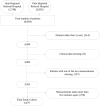Repeatability of RRate measurements in children during triage in two Ugandan hospitals
- PMID: 39775211
- PMCID: PMC11706398
- DOI: 10.1371/journal.pgph.0003097
Repeatability of RRate measurements in children during triage in two Ugandan hospitals
Abstract
Pneumonia is the leading cause of death in children globally. In low- and middle-income countries (LMICs) pneumonia diagnosis relies on accurate assessment of respiratory rate, which can be unreliable when completed by nurses with less-advanced training. To inform more accurate measurements, we investigate the repeatability of the RRate app used by nurses in Ugandan district hospitals. This secondary analysis included 3,679 children aged 0-5 years. The dataset had two sequential measurements of respiratory rate collected by 14 nurses using the RRate app. We measured agreement between respiratory rate observations while indicating observations' clustering around WHO fast-breathing thresholds. WHO thresholds are 60 breaths per minute (bpm) for under two months (Age-1), 50 bpm for two to 12 months (Age-2), and 40 bpm for 12.1 to 60 months (Age-3). We assessed the repeatability of the paired measurements per user through the Intraclass Correlation Coefficient (ICC) and calculated an overall ICC value. The respiratory rate measurement took less than 15 seconds for 7,277 (98.9%) of the measurements. Despite respiratory rates clustering around WHO thresholds, breathing classification based on the thresholds (Fast vs normal) was altered between sequential measurements in only 12.6% of children. The mean (SD) respiratory rate by age group was 60 (13.1) bpm for Age-1, 49 (11.9) bpm for Age-2, and 38 (10.1) for Age-3, and the bias (Limits of Agreements) were 0.3 (-10.8-11.3) bpm, 0.4 (-8.5-9.3) bpm, and 0.1 (-6.8, 7.0) bpm for Age-1, Age-2, and Age-3 respectively. The repeatability of the paired respiratory rate measurements was high, with an ICC ≥ 90% for 12 of 14 users and an overall ICC value (95% CI) of 0.95 (0.94-0.95). The RRate measurements were efficient and repeatable. The simplicity, repeatability, and efficiency support its usage in LMICs healthcare facilities, and endorses a more widespread clinical adoption.
Copyright: © 2025 Asdo et al. This is an open access article distributed under the terms of the Creative Commons Attribution License, which permits unrestricted use, distribution, and reproduction in any medium, provided the original author and source are credited.
Conflict of interest statement
The authors have declared that no competing interests exist.
Figures



Similar articles
-
Repeatability of Pulse Oximetry Measurements in Children During Triage in 2 Ugandan Hospitals.Glob Health Sci Pract. 2023 Aug 28;11(4):e2200544. doi: 10.9745/GHSP-D-22-00544. Print 2023 Aug 28. Glob Health Sci Pract. 2023. PMID: 37640488 Free PMC article.
-
Usefulness of a mobile phone application for respiratory rate measurement in adult patients.Jpn J Nurs Sci. 2022 Jul;19(3):e12481. doi: 10.1111/jjns.12481. Epub 2022 Mar 14. Jpn J Nurs Sci. 2022. PMID: 35289085
-
Evaluating the Interrater Agreement and Acceptability of a New Reference Tool for Assessing Respiratory Rate in Children under Five with Cough and/or Difficulty Breathing.J Trop Pediatr. 2021 May 17;67(2):fmab046. doi: 10.1093/tropej/fmab046. J Trop Pediatr. 2021. PMID: 34124753 Free PMC article.
-
Respiratory rates observed over 15 seconds compared with rates measured using the RRate app. Practice-based evidence from an observational study of acutely ill adult medical patients during their hospital admission.Acute Med. 2020;19(1):15-20. Acute Med. 2020. PMID: 32226952
-
Antibiotic therapy versus no antibiotic therapy for children aged 2 to 59 months with WHO-defined non-severe pneumonia and wheeze.Cochrane Database Syst Rev. 2021 Jan 20;1(1):CD009576. doi: 10.1002/14651858.CD009576.pub3. Cochrane Database Syst Rev. 2021. PMID: 33469915 Free PMC article.
References
-
- World Health Organization. Pneumonia. 2021. Available from: https://www.who.int/news-room/fact-sheets/detail/pneumonia
-
- UNICEF. Childhood pneumonia explained. 2023 [cited 2024 Jan 3]. Available from: https://www.unicef.org/stories/childhood-pneumonia-explained#:~:text=Eve...
LinkOut - more resources
Full Text Sources
